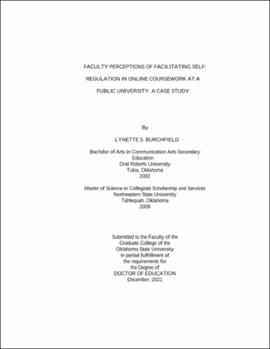| dc.description.abstract | Online course enrollments continue to increase, and even more online courses are now offered as a result of the pandemic (O'Keefe et al., 2020). Although some students succeed in online courses (Battalio, 2009; Murray et al., 2012), most either earn low grades or do not complete the courses (Angelino et al., 2007; Wilson & Allen, 2011). Some courses are more successful than others in facilitating the learning process for online students (O'Keefe et al., 2020; Johnson, N. et al., 2020). Self-regulation has proven to be a key feature for online learning (Carvalho, Sana, & Yan, 2020). One way to explain this issue is through the theory of self-regulation. Tabak and Nguyen (2013) developed a conceptual model of self-regulation in online learning environments that contains components from three theories: Self-Regulation Model from Bandura's Social Cognitive Theory (1991), Technology Acceptance Model (Davis, 1989), and the Five Factor Model of Personality (Barrick & Mount, 2005). Tabak and Nguyen's (2013) model explains self-regulation in an online learning environment as a continuous looping system and accounts for the roles and interaction of intrinsic factors and extrinsic factors, perceived ease of use and perceived usage as antecedent effects on the forethought, performance, and self-reflection phases of self-regulated learning. This qualitative case study uses constructionism to explore the significance of the modifications effective instructors made to course design and to the student learning factors and processes in their online courses that facilitated self-regulated learning. This case occurred during the crisis of the COVID-19 pandemic. Findings in this study indicate instructors used course design modifications exemplifying support for and facilitation of learning processes so students were able to progress through the overall learning process smoothly. The results of this study could provide key insights for online educators to better support student self-regulation in online courses and may also provide educators with possible improvements in course construction, academic support, and time saving measures connected to online students and online courses. | |
